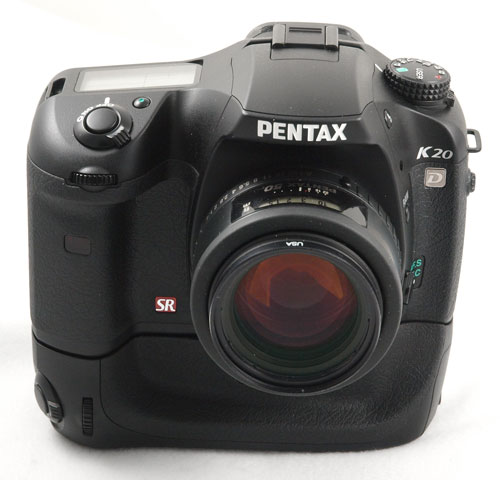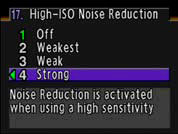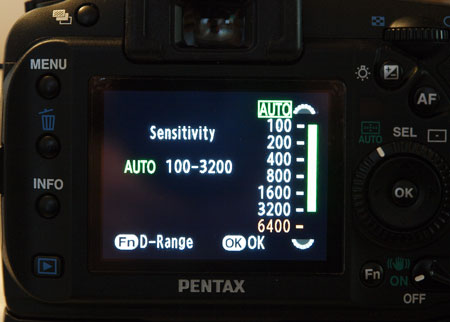Resolution and Image Quality

Our early impressions of the K20D were pretty positive with the fast Pentax 50mm f1.4. As always with recent screw-drive AF, the lens focusing is reasonably fast (if not blistering) and noise is much greater than the excellent Canon Ultrasonic motor lenses - which are now most of the better lenses in the Canon line. We had a K10D for comparison and the K20D seemed faster in AF, even though Pentax makes no claim of improvements in AF with the K20D.
The 14.6 MP CMOS sensor actually allows an ISO Boost to 6400, so the new ISO 3200 and ISO 6400 were the next features to tackle. By default the K20D high ISO noise reduction is set to off. This resulted in usable but grainy images at ISO 3200 and an ISO 6400 performance that was too coarse to be useful for our needs.

However, with the "weakest" and "weak" high ISO Noise Reduction settings, our first impressions in pixel-peeping high ISO images was much more favorable. The images with a small amount of noise reduction were pretty good - much better than we had expected. We had to wonder if early reviewers had noticed that high ISO noise reduction is completely off by default.
Images to ISO 1600 were quite good; 3200 shows deterioration in the shadow areas, but it is still very usable - even for large prints. ISO 6400 quality is better with a little NR and it would be usable for smaller prints or the web-posting we do, but too much is lost for large prints. All in all this is an outstanding performance for the new Samsung 14.6 MP sensor. Like many others, we wondered how good a new sensor from Samsung could be compared to Canon, Nikon, and Sony. More testing will be done in this area, but our first impressions are that the Samsung sensor is quite competitive, capturing more detail than the competing Nikon, Sony, Olympus, and Canon prosumer models.

Auto can be set to any ISO range you want, a feature Canon still refuses to implement fully. Based on early test shots we wouldn't hesitate to set the auto range from 100-1600 on a routine basis and 100-3200 if we were going into a low-light situation - or for times when the highest possible shutter speed is required. We would reserve 6400 for those special situations where the trade-offs make it worthwhile.
Whenever there is a recent Pentax is in our hands, we are again reminded of the usefulness of Hyperprogram, where you can instantly shift the aperture or shutter speed (front and rear dials) with the camera shifting other program parameters. Like the K10D, the K20D continues the unique TAv (Time & Aperture) Priority program, where you can select the shutter speed and the aperture which remain fixed while the program dynamically changes the ISO to maintain shutter speed and aperture. Selectable Auto ISO to 6400 on the one hand, and both TAv and Sv (Sensitivity or ISO) programs with the same range on the other hand, make the K20D a remarkably flexible digital SLR.










50 Comments
View All Comments
solar1 - Tuesday, March 11, 2008 - link
First let me give praise for covering aspects of this camera that few reviews bother taking.I did go to the japanese pentax website some time ago where they have absolutely stunning webpages for the K20D, but in Japanese. So with the funky google translation, I was able to get a bit of an idea on the new camera before it showed up in shops. I thought it was a mistranslation regarding this illustration function - it sounds really interesting. Please do show an image or two in your upcoming review... and thanks for bringing up the topic.
The Irish Patient - Tuesday, March 11, 2008 - link
Not a big deal, but the 10d used a pentaprism viewfinder instead of the more common pentamirror setup, and the viewfinder could be removed to use interchangeable focus screens.Does the 20d retain these features?
hiepbiz - Tuesday, March 11, 2008 - link
In fact, if you bought the Katz Eye one, you can switch it to the new K20D without any problem. Pentax does have my vote in backward compatibility department.The Irish Patient - Tuesday, March 11, 2008 - link
I wouldn't usually clutter up a forum with a "thank you" post, but your reply deserves an exception.The Katz Eye Focusing Screen you directed me to is exactly what I had hoped to find. OK, I'm a dinosaur, but I still prefer to focus manually as on my antediluvian Nikon. For those readers that have never seen what manual focus is supposed to look like on an SLR, the Katz screens have both the central split prism and a surrounding microprism ring.
I said in my original post that the ability to swap out the focusing screen on the k20d was not a big deal, but now it's a very big deal for me. I just hope I can get a decent price on my XTi now that the XSi has been announced.
Wesley Fink - Tuesday, March 11, 2008 - link
Yes the K20D continues to use a real pentaprism and it does feature interchangeable focusing screens. The lower-end K200D will use a pentamirror like the Sony A350/A300/A200, Canon XSi/XTi, and Canon D60/D40x/D40spazmedia - Tuesday, March 11, 2008 - link
I still don't get why camera makers insist on increasing megapixel count on prosumer cameras. This makes little difference when printing at low iso and at high iso just makes things worse. The sensor made by Samsung look interesting, if only they did not increase the resolution.also does the K20 display iso setting in the viewfinder?
Wesley Fink - Tuesday, March 11, 2008 - link
I remember when 1 megapixel was touted as all one could ever want or use in a digital camera :) Pentax claims that the 14.6 megapixel resolution matches the resolution of 35mm film. Others might claim 35mm film resolution is a bit higher than this. I really don't think the resolution wars will ever be over, but like reducing manufacturing traces in computer CPUs each improvement in speed introduces a new set of problems to be resolved.The resolution wars are slowing a bit right now as we do approach 35mm resolution, but anyone who shoots medium format or view cameras knows there is much more resolution beyond 35mm film. It will be great when we can shoot those higher resolutions with a small digital camera. Of course hitting the 35mm film resolution range is also hitting the resolving limit of most current lenses, so future lenses will require even better optics.
We have already seen that the develpoing move to full-frame by Sony, Nikon, Canon is requiring the best optics available as average lenses are obviously inferior on those bigger, higher-resolution sensors. Future resolution increases will likely require an optics quality revolution to have much relevance.
madgonad - Tuesday, March 11, 2008 - link
35mm film is actually about 10MP. Maybe a little less for lower quality films.The motion picture film libraries have been scanning at the maximum discernible resolution for a while to create digital masters of the movie archives. They are scanning at 4K resolutions which is the equivalent image of about 10MP. You can shoot at higher resolutions but eventually all you are doing is just magnifying the image and requiring more and more light for proper exposure. I am not actually sure what human vision translates into megapixels.
yyrkoon - Tuesday, March 11, 2008 - link
Human eye 'MegaPixel' equivalent in a camera last I read was somewhere above 32 MP(some argue 64MP, some argue higher). wikipedia claims 81MP.http://en.wikipedia.org/wiki/Eye">http://en.wikipedia.org/wiki/Eye
Personally, I am happy with 6MP, but very unhappy with the current Dynamic range capabilities of ALL cameras. From what I have read, the human eye has a static contrast ratio of 100:1(about 6.5 stops), but a dynamic contrast ratio of 1,000,000:1 (about 20 stops). All this is what I have read from wikipedia, but I have read other 'articles' that have claimed similarly.
Wesley Fink - Tuesday, March 11, 2008 - link
I completely agree that the biggest challenge in today's digital cameras is dynamic range. Another reader chided me for not spending some time talking about the dynamic range expansion feature on the K20D that allows expansion at the top and bottom of the dynamic range. We will try to cover this in the full review.I could also agree with you about the limitations of film dynamic range, except that I find digital imaging is still far more limited in dyanamic range than film. When it reaches film level I can expand my complaints.